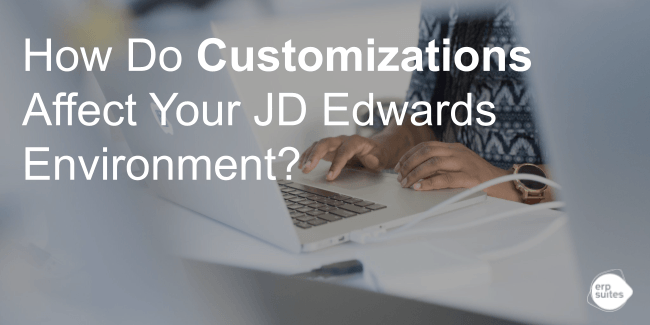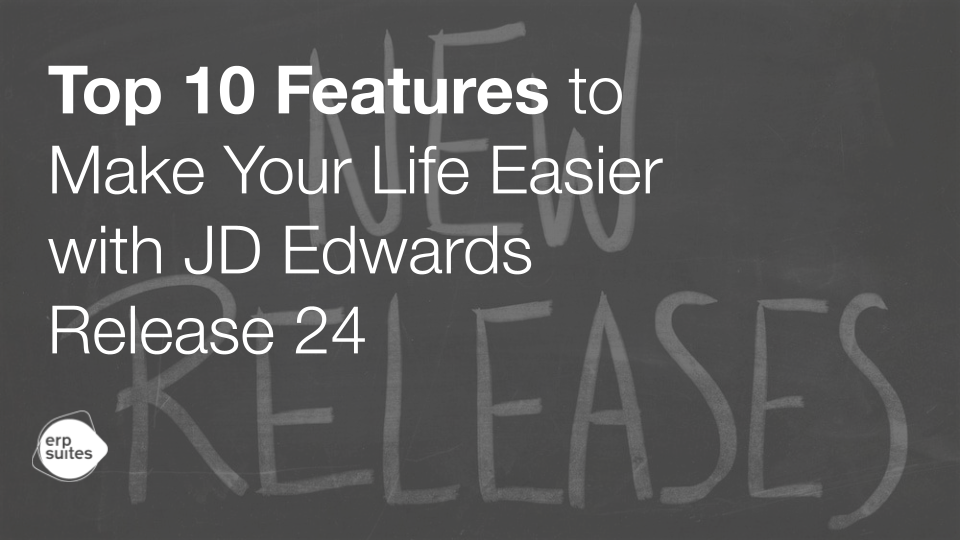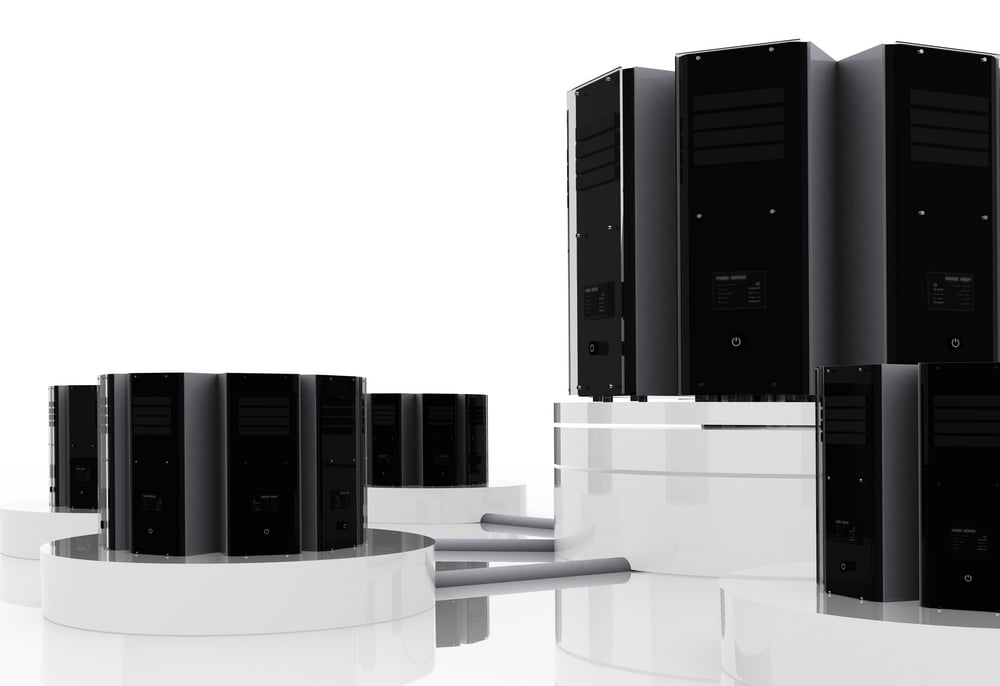JD Edwards Upgrades Made Easy: From Code Current to Automation
October 1st, 2025
13 min read
This special edition of Not Your Grandpa’s JD Edwards highlights how Hamilton Telecommunications and Alageney County are modernizing JD Edwards systems through automated testing and orchestrations. Hamilton shares their journey of implementing automated testing to shorten upgrade timelines, reduce user involvement, and improve accuracy. Alageney County demonstrates how orchestrations have transformed their processes—streamlining vendor creation, onboarding, payroll, and year-end close—saving weeks of manual effort while reducing errors. Both organizations emphasize the importance of staying code current, reducing customizations, and leveraging modern tools to maximize efficiency, free up resources, and support long-term business growth.
Table of Contents
- Automated Testing Project at Hamilton
- Key JD Edwards Applications at Hamilton
- Introduction to Alageney County
- Challenges Leading to Solutions
- Leveraging Orchestrations and Tools
- Results, Advice, and Final Reflection
Transcript
Introduction to Hamilton Telecommunications
How do you cut down upgrade timelines without overloading your team? And how can orchestration save weeks of manual work in JD Edwards? In this special edition of Not Your Grandpa's JD Edwards, we sit down with Hamilton Telecommunications and Alageney County to hear how they're tackling these challenges headon. Stick around. You'll learn how two very different organizations are modernizing JD Edwards with real strategies you can take back to your own business.
Uh but welcome to a special edition of Not Your Grandpa's JD Edwards podcast. Uh we're here with Hamilton Telecom. But if you want to explain your role a little bit, maybe introduce yourself and uh we can get started.
Sure. Uh my name's Peggy Christensen. I manage the enterprise software and data services group at Hamilton Telecommunications. Uh we are a local telephone company in central Nebraska. We also have businesses that offer managed services to uh for IT to businesses and a relay business for the deaf and heart of hearing. That's a nationwide business.
That's awesome. That's awesome. That's incredible. Um can you walk us through a recent JD Edwards project that you undertook? Yeah, we've we tend to do uh multiple projects and one of the them that we are in the midst of at the moment is to implement an automated testing software. So at this point we have of course downloaded the software. We've done some training with regard to how to use this software with J Edwards and we're in the midst of creating our test scripts so that we can minimize the testing that user groups have to do when we do upgrades or take ESUS uh during our regular course of business.
Automated Testing Project at Hamilton
Can you walk us through a recent JD Edwards project that you undertook? Yeah, we've we tend to do multiple projects and one of them that we are in the midst of at the moment is to implement an automated testing software. So at this point we have of course downloaded the software. We've done some training with regard to how to use this software with JD Edwards and we're in the midst of creating our test scripts so that we can minimize the testing that user groups have to do when we do upgrades or take ESUS during our regular course of business.
Yeah. So is would you say that that was like your biggest business problem that would be being solved here or is there like more of an underlying it's going to hopefully fix some other things in the future as well? Yeah. So, a couple of things there. Uh, we are on a code current journey as most JD Edwards customers are and our most recent release is 23. So, uh, we're a couple of years back and so we are wanting to upgrade to either release 25 or 26 in the near future. And so, we want to get these test scripts built so that we can use them for that project and have a shorter timeline and a less user involvement. Of course, we want the users to be involved in in some capacity, but we don't want them to be taken away from their day-to-day jobs and have to do a lot, you know, heavy lifting on the on the test side. So, we're trying to help them out in that way.
Yeah, that's awesome. I mean, to have your users be involved is obviously everybody wants that, you know, you got to have somebody that is understanding what that whole process is looking like, but you're right, codec current is one of the highest talked about things. It's that AI these days. I swear that's the most of the conversations I've had this week. Uh but so back to the more project side of things. Uh what what was the results that you're seeing now that you're actually getting into the later part of the implementation?
Yeah, what we're seeing is um a lot of learning. So at this point um we have a newer business analyst on our team and she was unfamiliar with JD Edwards when she came into our group. And so um she's been doing a lot of the test scripts which has uh been a twofold process here. One is learning the new automated test software uh and two to learn a lot more about JD Edwards and how JD Edwards works and the processes that we use in at Hamilton. So that has been our biggest step so far. Uh and we really think that our next step is going to be that big leap when we take your NDSUs for example. We've concentrated a lot on our HR test scripts and our 1099 sort of test scripts so that we can um take advantage of the testing software automation once we take those ESU sets.
Yeah, love that. Um but if you could like if you had to redo this project, you know, go back to the start, what's something that you would maybe change or maybe tell yourself like, oh, look out for this? Yeah. So we have done this project implementation along with other projects and we probably haven't cleared enough time on the schedule for our existing business analysts you know rather than the newest one to be able to really get into the testing software and learn and understand it. So I think some more concentrated time on the schedule for our business analysts to be able to really dive in. um they've been able to tinker in it, but other than our our newest business analysts haven't been able to spend a lot of concentrated time because they're working on tickets every day. So, probably organizing our time in a little bit better fashion would be my my uh my redo.
Yeah. I mean, something about getting organized is something that we talk about a lot on this podcast, but also as a business. It's one of those things that you really don't think about until it's time for an upgrade. it's time for a project and you're like, "Oh crap, like why haven't we done X, Y, and Z?" Um, and yeah, we can always look back and hindsight's 2020. It's very easy to see what you we could have done. But I mean, I'm sure it's something that you all will carry into future projects and even just managing your data and everything in JD Edwards going forward, which is awesome.
Yeah, we really do try to take a look at lessons learned from each of our projects and try to apply that to the next one. And we try to learn from how other folks have done it at in focus or blueprint. Um so that we can you know not only learn from what we did not so well one time but but from what others have have said or their lessons learned as well.
Key JD Edwards Applications at Hamilton
In terms of your operations, is there a specific JD Edwards application that stands out that you say, "Yeah, using this has helped us so much." Is there anything that stands out to you? I think uh probably our financials. We use JDER's financials of course and um those processes obviously really drive our business. Uh we also pretty heavily use the HCM module uh human capital management. So both of those modules are really well used from our side and and drive a lot of our decision making.
Um clearly yeah employees dollars right uh pretty important information. We're also working very hard on um how we understand uh our financial information in um an external system like PowerBI or other tools outside of JD Edwards along with our financial reports of course um but that has been an interesting journey as well.
Yeah, PowerBI is something I am way too familiar with. Uh used to use it in my old jobs and everything like that. So very impressive stuff. But this has been a special edition of Night Your Grabers J Edwards. A little bit of a live situation which is pretty cool. We don't get to do that too much since we're all remote. Um but again, thank you so much for joining us and uh I hope to see you on the podcast again. Maybe we'll talk about some other stuff like new upgrades or some other stuff that you're doing just to maybe will help out somebody else that's going through a similar issue.
Sounds great. Thanks for having us.
Introduction to Alageney County
So start off, you guys want to tell us a little bit about Alageney County and uh maybe a little bit about your roles as well. So get a little bit.
Sure. Alageney County implemented JD Edwards back in 2002. Our old system was called famous. Um, I've been with the Alagana County Controllers Office since 2004, starting out in payables and working my way into a business analyst role and now am the manager of the JD Edwards shared service center um, where we support all JD Edwards users projects regarding JD Edwards um, and oversee financials and payroll on the JD Edwards system.
Um I'm the assistant manager uh with the JD Service Center at LA County and I've been here for about 10 years and supporting you know what he just went over.
That's awesome. Well, obviously you guys have Have you worked together for a long time? Have you been with Alageney for a while?
Yeah, I've been there for 21 years.
That's awesome. That's awesome.
I've been there for about 10 years.
That's awesome. Well, I'm sure you guys really love it. Obviously to stay somewhere that long is very impressive but must have a good culture and everything that you guys are building which is great and that's I know that we love working with you guys so makes a lot of sense.
Challenges Leading to Solutions
But to go back to your last project or maybe even the little things that you've done since then what is like a challenge or a frustration that really led you to start looking for a solution? So what happened was our operating system was going to going out of support. Um and at the time some folks with the county that had a lot of years of AS400 knowledge and IBM knowledge were getting ready to retire.
Yeah. I mean obviously from our end as well. We're very happy about your business and definitely uh growing especially with everything that I'm sure you've learned at the few sessions that you may have gone to and different stuff here. Um I know AI is a big thing that everybody is talking about. I mean you could throw a stone out there and hit about 10 people that talking about AI in a session today. So um it's it's very exciting where the JD Edwards world is truly going.
But in terms of what was happening in your business before, um, was there like I mean obviously you were talking about a little bit of the pain points and like what led you to do that, but I'm sure like when it came to the onboarding side of that and the implementation side of that of bringing that person on to help you with um, Vertex, right? Um, when someone was coming on, what was that process like? Was it easy? Was it seamless? Or were there some hiccups that happened along the way? No, the process was really seamless. Um, or am I allowed to name name? Sorry.
Yeah, I mean, we primarily work with Amy Dish on the AS400 team. Um, and she was great as far as walking us through what we needed to do as far as having an internal Vertex administrator on our team um to get the download, how it should be downloaded, where we need to put the files for her. um working with us collaborately to get it onto the test box of the AS1400 and working through the testing process with the internal business analyst and payroll team to make sure we were successful before pulling the trigger in production which we did on off hours.
That's awesome. Uh was there anything about that process that maybe surprised you like even in a good way but maybe a bad? Um I was a little surprised to learn that um the prior vertex administrator on our end was doing a lot of unnecessary work with um creating new libraries with new vertex IDs every time um he would do an install and we learned that that wasn't needed that we can have one vertex ID um and then sort of like one library that gets updated each time.
So, we used to have to go into JD Edwards and make like a lot of um credential changes in a program called P7308, the update like the current Vertex ID, the library, the password. And now moving forward because of the shortcuts um that Amy Bish had found and things that we were doing unnecessarily. We don't have to take those additional steps each time. It'll just stay that way going forward.
Leveraging Orchestrations and Tools
Yeah. Made it a lot easier, I'm sure. A lot less time consuming stuff. Um, so other than that, like what other changes have you seen since using the new solutions that you have like with the tools release for sure, but also with Amy Bishop coming on board or at least kind of on board at that point. Um, so I feel that with the new tools release, um, it's we're doing a lot more with with tools and with orchestrations. We're now using theuler to run orchestrations. We're using the monitors. Um we're definitely really using orchestrations way more than used to.
Um we're doing a lot of um loading data into JD Edwards um by by putting files on SFTP site um having orchestrations read them and load that data into JD Edwards. Um to give you an example, at elections time we have to pay about 7,000 pole workers um for each election and sometimes it may not be the same pole workers each election. So we have to create vendors in JD Edwards for each of those pole workers um get payment there. So we've used orchestrations to read an Excel file that were provided by the elections department and the orchestration goes down that Excel file, reads all the information and creates all the vendors automatically in JD Edwards which saves the AP department days.
Yeah. Um probably at least three or four days worth of time creating all the vendors that they need to create.
That's awesome. Now uh with orchestrations, where did you start with that? if you remember of course but um what was like the first thing that you were like oh I wish that we could use orchestrations with this and then obviously it snowballed into other things as well. Do you remember what the first thing was?
So the reason why we started uh getting into orchestrations was because the Alageney County wanted to um select a different vendor for onboarding their employees. So you know JD Edwards continued was going to continue to be the system that cut the payroll. So to onboard his employees uh this vendor would have to send us daily files for new hires, rehires, changes, terminations, etc. So we had to get familiar with orchestrations because four different orchestrations were needed for those different actions to get those interface files into JDR. So that's really where um we had to start with orchestrations, of course.
And obviously it snowballed into using it for things that maybe you weren't even thinking about back then. We're sure. I mean, I'm sure that you it's woven throughout your business now. I mean, orchestrations is one of those things that yeah, you start small and ends up it can run half your business. Well, obviously not half your business, but a lot, which is another big one we use it for.
Um, at the end of the year, we have to cancel hundreds of we use that to cancel hundreds of POS for ones that aren't going to roll over to the next year. So now we just put those POS in a spreadsheet and we use orchestrations to cancel those POS that are not going to roll over to the next year.
Yeah. Um so in terms of the results like would you say that there's just a lot of time saved or is it more there's money also being saved or anything like that?
Oh, for sure. There's a lot of time saved like at the year end close. Um it's countless manh hours trying to close down purchasing, close down old old orders, um reverse receipt nonvouched um receipts and you know cancel those purchases um and orchestrations have made it so seamless and say it's probably a week to two weeks worth of time at like a very busy time of year mid December um with your man hours needed to manually do all those things.
That's awesome. I mean, yeah, it's hard for me to even really think about the amount of time that used to be spent uh before orchestrations or before some of this stuff was really put into full use, but I'm sure that the amount of time that you're shaving now, a lot of those people can work on other projects, can work on other things, and it's probably helped your business in ways that we can't even quantify right now. It also eliminates a lot of user error when you're working with those tedious processes. you know, employees kind of get, you know, less careless as they're doing a lot more of the same process. So, if you can put it in orchestration, it eliminates that ger error a lot of time.
Yeah. Which is great. I mean, I'm sure it saves you money in that way, too. If one of those errors happens, maybe something isn't closed down, right? Maybe something somebody's still getting paid for something, then to have to go and backtrack, figure out where they get that money from. Sure, there was a lot of pain points that really came from that.
Results, Advice, and Final Reflections
So, what advice would you give to a company that's maybe considering a similar decision about tools up tools release upgrade or just tools update in general or even using orchestrations?
I would say that for sure try the orchestrations. Start small then get big. They save hours and hours of time.
Um, and as far as, you know, the tools and doing updates, I mean, we're a small government. We have a very small team, but we're now learning that you want to stay as code current as possible and be on the most up-to-date release. um we're trying to get rid of we got rid of a lot of customizations during that upgrade and we have very few left and it makes it very seamless um to take a new release or or take a new jump to a new tools release.
So I would say it makes life easier to try to to stay as up to date as possible.
Yeah, I know. I mean going vanilla, it's something that we talk about a lot and it's really helped out a lot of customers. especially exactly like that, like when you're looking at an upgrade, when you're looking at something new that JD Edwards comes out with because they're always coming out with some crazy stuff, I swear. Um, but when that happens, I mean, to be flexible, that is one of the most important things that you can have in the JD Edwards system, which is fantastic.
But if you could go back in time, I know good old time travel theory here. Uh, what would you tell yourself before starting this journey?
I know it's a deep one. It's a deep one.
Um I would say, you know, be open to learning orchestrations even quicker because, you know, that's the AI and orchestrations is the direction. Um and JD Edwards if you want to keep your ERPA system up to date and you know come into the new world and it saves a lot of time, money, and it makes your department and company even more efficient.
Exactly. Yeah. Save a lot of money. saves a lot of time. That's fantastic.
All right, that's all I have for you. This has been a great segment of Not Your JD Edwards. Seriously, thanks for taking the time talking with me. I know, busy day. A lot of sessions. I'm sure you guys are tired. I know I am. If these stories inspired you, don't forget to follow Not Your Grandpa's JD Edwards on YouTube or Spotify. And if your organization is ready to cut down upgrade times, reduce manual processes, and modernize your JDE system, connect with ERP Suite. We'd love to help you write your own success story. That's it for this special edition of Not Your Grandpa's JD Edwards. Huge shout out to Hamilton Telecommunications and Alageney County for sharing their journeys with us. Whether it's automated testing or orchestrations, these stories prove that modernizing JD Edwards isn't just about technology. It's about freeing up time, reducing risk, and making your team more efficient. We'll be back soon with more customer stories, insights, and strategies from across the JD Edwards community. Thanks for tuning in, and we'll see you next time.
Video Strategist at ERP Suites
Topics:


.png?width=650&height=325&name=Blog%20Images%202_1%20(2).png)
.png?width=650&height=325&name=Blog%20Images%202_1%20(1).png)

.png?width=960&height=540&name=Blog%20Images%20(98).png)
.png?width=960&height=540&name=Blog%20Images%20(88).png)
.png?width=960&height=540&name=Blog%20Images%20(86).png)
.png?width=960&height=540&name=Blog%20Images%20(85).png)
.png?width=960&height=540&name=Blog%20Images%20(83).png)
.png?width=960&height=540&name=Blog%20Images%20(75).png)
.png?width=960&height=540&name=Blog%20Images%20(71).png)
.png?width=960&height=540&name=Blog%20Images%20(3).png)










